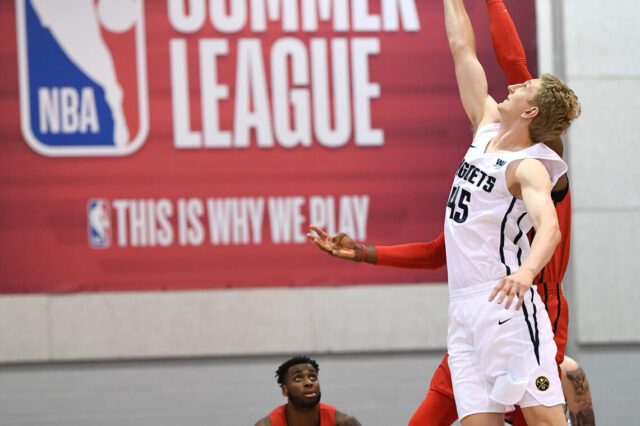There was a day last week on Twitter that turned into a Nikola Jokic vs DeMarcus Cousins debate about which guy was the better offensive player. It happened to be the same day I released my center rankings, which can be found here if anyone wants a refresher. In the ranking, Jokic came in at 3rd overall, while Cousins came in at 4th. The piece was statistically based, focusing mostly on the numbers rather than the situation.
The debate between these two players is rather polarizing, because more than anything, fundamental questions about basketball itself must be answered. Multiple factors determine how valuable one’s scoring is, but at its core, two factors stand above the rest:
- The frequency a player attempts to score
- The frequency a player actually does score
Cousins and Jokic are (according to most) the opposite ends of the spectrum. As star centers go, Cousins makes his money by attacking the defense again and again. He wears down opponents through sheer physicality and will. He’s also added a 3-point shot to his arsenal, and he shot 37.5% on over five 3-point attempts a game. His combination of usage (finishing possessions himself) and assist rate (helping others finish possessions) is incredibly high for a center, and it’s because he does most of the work by himself.
Jokic, on the other hand, is the ultimate team player and unselfish to a fault. He passes up good shots of his own for great shots for his teammates, and when he finally does take his own shots, they combine both “excellent situation to score” with “excellent skill to accomplish the task.” This type of production doesn’t show up in the raw numbers as much as a volume scorer, but it does show up in box score variation between himself and his teammates.
To the general public, frequency of attempts has always trumped frequency of makes. In recent years, things began to change. LeBron James’ MVP season with the Miami Heat in 2012-13 showed that quality players can also make quality decisions with the basketball. Since then, the world has prioritized efficiency more and more. Players like Stephen Curry and James Harden have grown into the most important in the entire NBA, but they’re skills were cultivated because of how efficient and valuable the shots are that they attempt.
On the other hand, volume still matters greatly. Russell Westbrook just posted one of the most impressive seasons ever from a sheer volume standpoint. By efficiency standards, he was almost perfectly average, but it was pretty clear that he had at least a top 3 offensive season last year. Maybe even the best season. There is a reason Westbrook won MVP this year, and that’s because efficiency was a smaller factor in the larger picture of his candidacy.
This content is no longer available.
So, how can both factors be true? How is efficiency increasingly important if Westbrook won MVP? How can Jokic be one of the top centers in the NBA if volume is what matters most to fans?
This is my attempt to marry both factors: production and efficiency, in one way. I call it: Scoring Ratio.
(On an aside, I need a better name for it, so if anyone has ideas, let me know)
Scoring Ratio combines two descriptive statistics representative of the two fundamentals of scoring: usage rate and true shooting percentage. Both are based on possessions that include free throws, which remain a major factor in today’s NBA.
The idea of usage rate (USG%) remains to quantify the percentage of a team’s possessions a single player uses. True shooting percentage (TS%) quantifies one’s efficiency based on how many points they score over a period of attempts. These are two metrics I respect for their simplicity and effectiveness in measuring contributions from player to player.
In order to qualify for Scoring Ratio, a player must have played 1,000 minutes this year or showed up on one of my five lists. Here is a documentation of each of the 280 qualifying players’ USG% and TS%.
This content is no longer available.
The average USG% for the 280 qualifying players was 19.5, while the average true shooting percentage was .5534. These marks are represented by the X axis and Y axis respectively. The blue line is the trend line. For these 280 players, as usage rate increases, true shooting percentage increases, though to a much smaller degree.
To be a truly impactful scorer though, one must possess both traits. Quadrant 1 (top right corner) represents this group. They are the most positively impactful scorers in the NBA. Quadrant 2 (top left corner) represents players that are above average in TS% on below average usage. These are most likely 3rd, 4th, or 5th scoring options that capitalize on their opportunities. Quadrant 3 (bottom left corner) represents the worst scorers. Quadrant 4 (bottom right corner) represents the volume scorers on below average efficiency. This group is the hardest to quantify, but generally, the reputation as a scorer extends further than the player’s actual worth.
The most efficient scorer this year was Tyson Chandler of the Phoenix Suns. His .703 TS% is very impressive; however, his usage rate was the seventh worst among all measured players as well. Dwyane Wade posted the 13th highest USG%, higher even than his former teammate Jimmy Butler, yet his TS% came in at just .508, 240th out of 280. How can one quantify who the better scorer was between Chandler and Wade this past year if both factors matter?
The best way statistically is to draw a “Y = -X” inverse line across the graph or close to it. This line represents the average correlation between positive USG% and positive TS% and helps determine whether players in quadrants 2 and 4 are positive or negative scorers. Fall to the right of the line, and the player is positive, or above average. Fall to the left of the line, and the contribution was negative, or below average. The line is actually 45 degrees from the trend line exactly, meaning that true shooting percentage is given slightly more weight than usage rate in the final stage.
Here are Wade and Chandler on the graph:
This content is no longer available.
It’s hard to tell based on the size of the picture, but Wade’s Scorer Ratio is greater than Chandler’s. That said, the mere fact that both players are as close to each other as they are should indicate that the concept of effective scoring should be reevaluated.
Here are the top six and bottom five scorers according to Scorer Rating:
This content is no longer available.
Top six scorers:
1. Russell Westbrook – Oklahoma City Thunder
2. Isaiah Thomas – Boston Celtics
3. James Harden – Houston Rockets
4. DeMarcus Cousins – New Orleans Pelicans
5a. Kevin Durant – Golden State Warriors
5b. Stephen Curry – Golden State Warriors
Botton five scorers:
5. Luol Deng – Los Angeles Lakers
4. Andre Roberson – Oklahoma City Thunder
3. Brandon Rush – Minnesota Timberwolves
2. Stanley Johnson – Detroit Pistons
1. Kris Dunn – Minnesota Timberwolves
Standouts from the top list include Thomas at second overall and Cousins coming in over Curry and Durant. I’ve been singing Thomas’ praises as a scorer throughout the offseason. The diminutive point guard is one of the three most impressive players in quadrant 1, and his rise has been incredible over the last three seasons. Cousins being fourth is a direct reflection of his usage rate, which was easily second in the NBA at 36.5. While Cousins made it into quadrant 1, it was just barely, and him being there is far less valuable than Curry and Durant being firmly in the quadrant.
Standouts from the bottom list include Roberson on the Thunder and the two young guys, Johnson and Dunn. Roberson will continue to be a starter this season, and his defense makes him a valuable commodity. Still, it’s hard to be a good offense when he’s on the floor. Johnson and Dunn still have time to turn things around, but they were far and away the least efficient qualifying players in the NBA. That’s a bad sign.
Because this is a Nuggets blog, I went ahead and pulled the Scoring ratio for all qualifying Nuggets players from last year.
This content is no longer available.
I added Westbrook so readers can continue to admire him, but the real story here is the Nuggets. There are a few interesting tidbits. Juancho Hernangomez was a slight negative due to his low usage, which isn’t surprising. As valuable as his ability was to hit 3-pointers this year, it was infrequent enough to stay below average overall. As he continues to become more comfortable and grow in his role, he will absolutely be a positive for years to come.
The four other negatives were Mason Plumlee (who gets a slight pass due to being a midseason acquisition) and the three point guards: Jameer Nelson, Jamal Murray, and Emmanuel Mudiay. It should surprise no one that Jamal Murray was the most impactful scorer of the group. Murray was born and bred to get buckets, and while the rest of his game was shaky, him being only a slight negative should be encouraging for the Nuggets future.
The last factor is the replacement of Danilo Gallinari, who was clearly the second best scorer on the Nuggets last year. Paul Millsap isn’t the scorer Gallo is, but he should become more efficient next year on lower usage. Players like Jokic, Hernangomez, Gary Harris, and possibly Murray will have their usage increased next season, and it should make up the difference with Gallinari gone.
Finally, here is a comparison for all of the top scoring centers in the NBA:
This content is no longer available.
Ranked from 1 to 12:
1. DeMarcus Cousins – New Orleans Pelicans
2. Karl-Anthony Towns – Minnesota Timberwolves
3. Nikola Jokic – Denver Nuggets
4. Enes Kanter – Oklahoma City Thunder
5. Brook Lopez – Los Angeles Lakers
6. Rudy Gobert – Utah Jazz
7. Clint Capela – Houston Rockets
8. DeAndre Jordan – Los Angeles Clippers
9. Marc Gasol – Memphis Grizzlies
10. Dwight Howard – Charlotte Hornets
11. Greg Monroe – Milwaukee Bucks
12. Hassan Whiteside – Miami Heat
First of all, holy cow, the Western Conference has some great scoring centers and the Eastern Conference…does not. The top nine scoring centers come from the West, and two of the three centers in the East, Howard and Monroe, could possibly come off the bench this season.
Again, the usage rate pushes Cousins over the top here. He utilized so many possessions that it didn’t matter that Jokic was nearly eight percentage points more efficient, as Cousins utilized 13 percent more possessions than Jokic. In a system like this, it’s hard for Jokic to come out on top.
Elsewhere, Enes Kanter is an elite offensive player, not just center. Don’t let anyone tell you differently. He may be the worst defensive player in the NBA, but his offensive game should warrant no criticism. Rim runners in Gobert, Capela, and Jordan scored better than Marc Gasol. The Spaniard had a normal year efficiency wise, but his efficiency is merely average, and the usage rate didn’t make up for it. Being a rim runner is an important offensive skill, and while the aforementioned trio don’t do as much creation with the ball in their hands, it doesn’t prevent them from being quality offensive players.
Back to the fundamental questions though: sifting through this data, it became apparent to me that players in quadrant 4 (bottom right) and the lower section of quadrant 1 (top right) are the most overrated scorers in the game in terms of added value. Guys like Russell Westbrook, DeMarcus Cousins, DeMar DeRozan, John Wall, and Dwyane Wade are all considered star scorers. For Westbrook, this is unequivocally true, and he is exempt from any slander. The other four though, this is probably true.
Here are the On-Off Offensive Ratings for each of the four “star” scorers:
| Player | O Rating ON | O Rating OFF | Diff |
|---|---|---|---|
| DeMarcus Cousins | 106.5 | 106.4 | +0.1 |
| DeMar DeRozan | 112.3 | 112.1 | +0.2 |
| John Wall | 114.6 | 103.8 | +10.6 |
| Dwyane Wade | 105.8 | 109.3 | -3.5 |
The only guy to have a truly positive impact on the offensive On-Off numbers was John Wall, and the reason isn’t even Wall’s scoring. It’s a combination of his ability to facilitate for others, the time he shares with Bradley Beal and Otto Porter, and the inability of the Wizards’ bench point guards behind him.
This is the premise of the flawed debate between DeMarcus Cousins and Nikola Jokic. Cousins puts up big, empty numbers and passable percentages that surface argument analysts claim to be superior. Using a metric like scoring ratio, the playing field is leveled. Cousins isn’t the behemoth anymore that puts up 27 points night. He’s the guy who throws up 20 shots to get there.
The idea of scoring ratio is that the individual in question is the best option on the court while taking the shot. The biggest flaw of all is that scoring the basketball is considered an individual task and accomplishment, when in reality, a great scorer can both work the offense and let the offense work for him.
There are some supporting cast issues to consider, but in Cousins’ case, he played with a surprisingly good Rudy Gay for 30 games and only passed the ball when he was forced to pass. He then played with Anthony Davis in New Orleans during the second half of the season, stopped passing as frequently, stopped taking as many shots, and was only two-tenths of a percentage point better using TS%. Cousins played with good enough players this year that should have created a more efficient environment, but so far, he has yet to evolve into something better.
This content is no longer available.
Jokic on the other hand has continuously molded his game to winning games. It took him only his rookie season to match how many wins Cousins has generated in seven years, and it took him the second season to beat that record. From game to game, Jokic’s shot attempts change, but the individual and team efficiency do not. Jokic shot less than 50% from the field in just 15 of his 75 games last year (20% of the time). Eight of those games happened before December 15th when he reentered the starting lineup permanently. After Jokic joined the starters on 12/15, the Nuggets boasted the best offensive rating in the NBA, despite a combined 44 games missed from Danilo Gallinari, Wilson Chandler, and Kenneth Faried after that time period. Oh, and Denver changed point guards, made a trade for another rotation player, and built their offense on the fly.
It sounds like I’m bashing Cousins and praising Jokic like a homer, but these things are very real. Cousins is clearly an elite scorer. Doing what he does on the workload he possesses is incredibly impressive. That being said, he’s a borderline quadrant 1 player. If I’m selecting a star to be my first option for the next five years, I’m picking players firmly in the upper right hand corner of the graph. Isaiah Thomas, James Harden, Kevin Durant, Steph Curry. These are the first options one should want shouldering their offensive workload.
The big difference between Cousins and Jokic: Cousins is what he is as a scorer. Jokic is still 22, already passes, rebounds, and possesses better defensive numbers than Cousins, and he has a chance to join the best quadrant 1 scorers in the foreseeable future.
For now, Nikola Jokic is behind Cousins as an elite scorer. In terms of an elite overall player? Jokic has already passed him by.
This content is no longer available.


